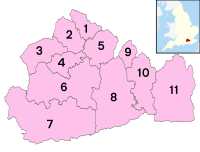
This article is about the county of England. For the Canadian city, see Surrey, British Columbia. For other uses, see Surrey (disambiguation).
|
Surrey |
|
|---|---|


|
|
 |
|
Coordinates:  51°15′N 0°25′WCoordinates: 51°15′N 0°25′WCoordinates:  51°15′N 0°25′W 51°15′N 0°25′W |
|
| Sovereign state | United Kingdom |
| Constituent country | England |
| Region | South East |
| Established | before 1066 |
| Time zone | UTC±00:00 (Greenwich Mean Time) |
| • Summer (DST) | UTC+01:00 (British Summer Time) |
| Members of Parliament | List of MPs |
| Police | Surrey Police |
| Largest town | Woking |
| Ceremonial county | |
| Lord Lieutenant | Michael More-Molyneux |
| High Sheriff | Julie Llewelyn (2021–22)[1] |
| Area | 1,663 km2 (642 sq mi) |
| • Ranked | 35th of 48 |
| Population (2021) | 1,189,934 |
| • Ranked | 12th of 48 |
| Density | 716/km2 (1,850/sq mi) |
| Non-metropolitan county | |
| County council | Surrey County Council |
| Executive | Conservative |
| Admin HQ | Woodhatch Place, Reigate |
| Area | 1,663 km2 (642 sq mi) |
| • Ranked | 24th of 26 |
| Population | 1,196,236 |
| • Ranked | 5th of 26 |
| Density | 720/km2 (1,900/sq mi) |
| ISO 3166-2 | GB-SRY |
| ONS code | 43 |
| GSS code | E10000030 |
| ITL | UKJ23 |
| Website | www |
| Districts | |
 Districts of Surrey |
|
| Districts | |
Surrey (/ˈsʌri/)[2] is a ceremonial and non-metropolitan county in South East England, to the southwest of Greater London. Surrey has a large rural area, and several significant urban areas which form part of the Greater London Built-up Area. With a population of approximately 1.2 million people, Surrey is the 12th-most populous county in England. The most populated town in Surrey is Woking, followed by Guildford.
The county is divided into eleven districts with borough status. Between 1893 and 2020, Surrey County Council was headquartered at County Hall, Kingston-upon-Thames (now part of Greater London) but is now based at Woodhatch Place, Reigate.[3] In the 20th century several alterations were made to Surrey's borders, with territory ceded to Greater London upon its creation and some gained from the abolition of Middlesex.
Surrey is bordered by Greater London to the north east, Kent to the east, Berkshire to the north west, West Sussex to the south, East Sussex to the south east, and Hampshire to the west.
View from Box Hill
Main article: Geology of Surrey
Surrey is divided in two by the chalk ridge of the North Downs, running east–west. The ridge is pierced by the rivers Wey and Mole, tributaries of the Thames, which formed the northern border of the county before modern redrawing of county boundaries, which has left part of its north bank within the county.[4] To the north of the Downs the land is mostly flat, forming part of the basin of the Thames.[4] The geology of this area is dominated by London Clay in the east, Bagshot Sands in the west and alluvial deposits along the rivers.
To the south of the Downs in the western part of the county are the sandstone Surrey Hills, while further east is the plain of the Low Weald, rising in the extreme southeast to the edge of the hills of the High Weald.[4] The Downs and the area to the south form part of a concentric pattern of geological deposits which also extends across southern Kent and most of Sussex, predominantly composed of Wealden Clay, Lower Greensand and the chalk of the Downs.[4]
Much of Surrey is in the Metropolitan Green Belt. It contains valued reserves of mature woodland (reflected in the official logo of Surrey County Council, a pair of interlocking oak leaves). Among its many notable beauty spots are Box Hill, Leith Hill, Frensham Ponds, Newlands Corner and Puttenham & Crooksbury Commons.[4]
Surrey is the most wooded county in England, with 22.4% coverage compared to a national average of 11.8%[5] and as such is one of the few counties not to recommend new woodlands in the subordinate planning authorities' plans. Box Hill has the oldest untouched area of natural box woodland in the UK, one of the oldest in Europe.[citation needed] In 2020 the Surrey Heath district had the highest proportion of tree cover in England at 41%.[6] Surrey also contains England's principal concentration of lowland heath, on sandy soils in the west of the county.
Leith Hill Tower
Agriculture not being intensive, there are many commons and access lands, together with an extensive network of footpaths and bridleways including the North Downs Way, a scenic long-distance path. Accordingly, Surrey provides many rural and semi-rural leisure activities, with a large horse population in modern terms.
The highest elevation in Surrey is Leith Hill near Dorking. It is 295 m (968 ft) above sea level[7] and is the second highest point in southeastern England after Walbury Hill in West Berkshire which is 297 m (974 ft).[8]
The longest river to enter Surrey is the Thames, which historically formed the boundary between the county and Middlesex. As a result of the 1965 boundary changes, many of the Surrey boroughs on the south bank of the river were transferred to Greater London, shortening the length associated with the county. The Thames now forms the Surrey-Berkshire border between Runnymede and Staines-upon-Thames, before flowing wholly within Surrey to Sunbury, from which point it marks the Surrey-Greater London border as far as Surbiton.
The River Wey is the longest tributary of the Thames above London. Other tributaries of the Thames with their courses partially in Surrey include the Mole, the Addlestone branch and Chertsey branch of the River Bourne (which merge shortly before joining the Thames), and the Hogsmill River, which drains Epsom and Ewell.
The upper reaches of the River Eden, a tributary of the Medway, are in Tandridge District, in east Surrey.
The River Colne and its anabranch, the Wraysbury River, make a brief appearance in the north of the county to join the Thames at Staines.
Like the rest of the British Isles, Surrey has a maritime climate with warm summers and cool winters. The Met Office weather station at Wisley, about 6.5 miles (10 km) to the north-east of Guildford, has recorded temperatures between 37.8 °C (100.0 °F) (August 2003)[9] and −15.1 °C (4.8 °F) (January 1982).[10] From 2006 until 2015, the Wisley weather station held the UK July record high of 36.5 °C (97.7 °F).[11]
| hideClimate data for Wisley, Guildford (1981–2010) | |||||||||||||
|---|---|---|---|---|---|---|---|---|---|---|---|---|---|
| Month | Jan | Feb | Mar | Apr | May | Jun | Jul | Aug | Sep | Oct | Nov | Dec | Year |
| Average high °C (°F) | 7.9 (46.2) |
8.3 (46.9) |
11.2 (52.2) |
14.1 (57.4) |
17.7 (63.9) |
20.6 (69.1) |
23 (73) |
22.7 (72.9) |
19.5 (67.1) |
15.4 (59.7) |
11 (52) |
8.2 (46.8) |
15.0 (58.9) |
| Average low °C (°F) | 2.1 (35.8) |
1.7 (35.1) |
3.4 (38.1) |
4.4 (39.9) |
7.3 (45.1) |
10.1 (50.2) |
12.4 (54.3) |
12.1 (53.8) |
9.8 (49.6) |
7.4 (45.3) |
4.2 (39.6) |
2.3 (36.1) |
6.4 (43.6) |
| Average precipitation mm (inches) | 61.8 (2.43) |
45.4 (1.79) |
44.1 (1.74) |
47.1 (1.85) |
51.3 (2.02) |
44.4 (1.75) |
46.3 (1.82) |
52.8 (2.08) |
54.4 (2.14) |
77.8 (3.06) |
67.9 (2.67) |
64.4 (2.54) |
657.7 (25.89) |
| Average rainy days | 11.4 | 8.9 | 9.3 | 9.3 | 9.2 | 8 | 7.1 | 7.7 | 8.6 | 11.1 | 10.8 | 10.9 | 112.3 |
| Mean monthly sunshine hours | 54.8 | 75.2 | 110.9 | 161.9 | 192.6 | 195.4 | 206.3 | 200.4 | 144.1 | 113.6 | 65.1 | 44 | 1,564.3 |
| Source: Met Office[12] | |||||||||||||
See also: List of places in Surrey and List of settlements in Surrey by population
The skyline of Woking, the most populous settlement in Surrey, as seen from the western approach by railway
Surrey has a population of approximately 1.1 million people.[13] Its largest town is Woking with a population of 105,367, followed by Guildford with 77,057, and Walton-on-Thames with 66,566. Towns of between 30,000 and 50,000 inhabitants include Ewell, Esher, and Camberley.[14]
Much of the north of the county, extending to Guildford, is within the Greater London Built-up Area. This is an area of continuous urban sprawl linked without significant interruption of rural area to Greater London. In the west, there is a developing conurbation straddling the Hampshire/Surrey border, including the Surrey towns of Camberley and Farnham.
Guildford is often regarded as the historic county town,[15] although the county administration was moved to Newington in 1791 and to Kingston upon Thames in 1893. The county council's headquarters have been outside the county's boundaries since 1 April 1965, when Kingston and other areas were included within Greater London by the London Government Act 1963.[16] The administration moved to Reigate at the start of 2021.[17]



